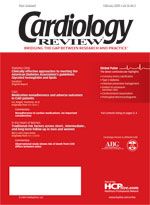Publication
Article
Left atrial volume and the risk of postoperative atrial fibrillation
Author(s):
Atrial fibrillation that occurs after cardiac surgery remains a source of increased morbidity and prolonged length of hospital stay.
Atrial fibrillation that occurs after cardiac surgery remains a source of increased morbidity and prolonged length of hospital stay. Although the incidence may be reduced by beta blockade, atrial fibrillation may still occur in 28% to 45% of patients undergoing cardiac surgery.1 Prophylactic administration of amiodarone (Cordarone) has met with variable rates of success and exposes a large population of patients to potentially serious side effects, including respiratory insufficiency, the need for increased inotropic and intra-aortic balloon support, and pacing.2 A reliable method of assessing the risk of developing postoperative atrial fibrillation is therefore necessary to identify those patients who may benefit most from prophylactic antiarrhythmic therapy.
P
Osranek and colleagues sought to identify the preoperative predictors of postoperative atrial fibrillation in 205 subjects undergoing cardiac surgery in the absence of mitral valve disease or a previous mitral valve procedure. Transthoracic echocardiography was obtained to assess left atrial volume and diastolic functional grades. Overall, 41.4% of subjects developed postoperative atrial fibrillation, and 60% received beta blockers. Using univariate and multivariable analyses, left atrial volume was the most significant predictor of atrial fibrillation ( < .001). A left atrial volume > 32 mL/m2 was a significant predictor of postoperative atrial fibrillation in subjects with and without beta blockers. A left atrial volume > 32 mL/m2 and age > 65 years was the strongest predictor of postoperative atrial fibrillation, with a 76.2% sensitivity and a 71.4% specificity. The negative predictive value of left atrial volume 32 mL/m2 and age < 65 years was 81%. These results are similar to those of Leung and colleagues, who found that increased left atrial and appendage areas and lower atrial ejection fraction seen on intraoperative transesophageal echocardiograms obtained immediately before coronary artery bypass graft (CABG) surgery were associated with a higher incidence of postoperative atrial fibrillation, especially in older patients.3
P
P
P
P
P
P
Unfortunately, these studies do not tell us whether the incidence of postoperative atrial fibrillation can be decreased in patients with abnormal atrial dimensions by using prophylactic antiarrhythmic therapy. Furthermore, only 60% of these subjects received perioperative beta-blocker therapy. Can the prophylactic administration of amiodarone decrease the incidence of postoperative atrial fibrillation? Bagshaw and colleagues sought to answer this question by performing a meta-analysis of 19 trials involving patients undergoing CABG surgery, valve surgery, and CABG plus valve surgery.4 They reported that amiodarone reduced the odds ratio of developing atrial fibrillation ( < .001), ventricular tachyarrhythmia ( < .001), and neurologic events ( < .02). Hospital stay was reduced by 0.6 days (from 9.9 to 9.3 days; < .001). There was no effect on mortality. However, these results must be viewed with caution. Although the overall incidence of atrial fibrillation was reduced from 27.9% to 19.6% in 9 of the 19 trials, the incidence of atrial fibrillation was ≥ 23% in the amiodarone-treated patients. The average incidence of beta blockade was only 37.4%. The doses, timing, and rate of administration varied greatly. In the Prophylactic Oral Amiodarone for the Prevention of Arrhythmias That Begin Early After Revascularization, Valve Replacement, or Repair (PAPABEAR) trial, patients received a week of pretreatment, which is not practical for the majority of CABG surgery patients who present with unstable symptoms.5 Finally, there was no uniform reporting of adverse events in these trials. However, there was a higher incidence of bradycardia (78% vs 48%; < .005) and the need for temporary pacing (48% vs 28%; < .05) reported in amiodarone-treated patients.
It is now clear that preoperative echocardiographic changes in left atrial morphology can identify patients who are at risk for developing atrial fibrillation after cardiac surgery. However, there is no evidence that the incidence of atrial fibrillation can be decreased in these patients by the prophylactic use of antiarrhythmic therapy in addition to routine beta blockade. A prospective randomized trial is necessary to determine whether the prophylactic use of antiarrhythmic drugs will decrease the incidence of atrial fibrillation in these patients. Furthermore, these potential decreases in atrial fibrillation must be shown to alter mortality, morbidity, and hospital length of stay while minimizing drug-related adverse events. In the meantime, patients with abnormal preoperative left atrial morphology should receive perioperative beta blockade, vigorous diuresis, and angiotensin-converting enzyme inhibitors, when tolerated, to reduce left atrial volumes and decrease left atrial distention by improving ventricular compliance and relaxation.






